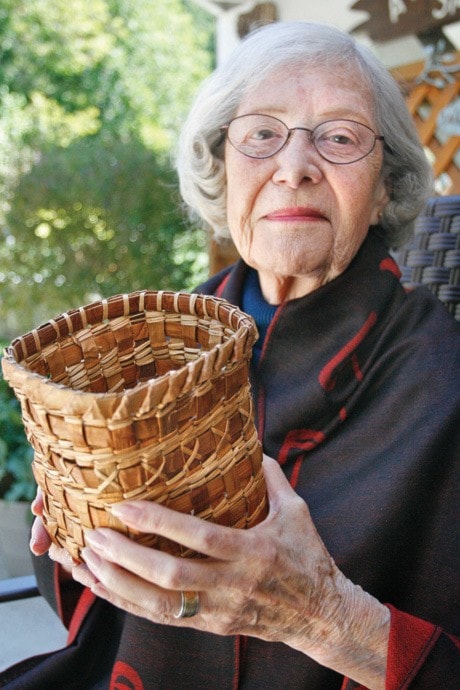A Colwood senior’s skin colour complicates her life in an unconventional way. Ann Studley has a light complexion which veils her First Nations’ heritage.
“My mother was dark skinned,” said the 81-year-old woman.
Being raised in a biracial household wasn’t as common when Studley was growing up. Her father was Caucasian and her mother from a Cowichan First Nation.
During most of her childhood, Studley didn’t realize it was different to have a brown mother. She spent her early years living in a logging camp near Rounds, B.C. Her family left the camp when she was 12 years old.
“I didn’t know my mother was different until we moved to Duncan,” Studley revealed. “Then everyone told me my mother was different.
“For a while I was shameful of my mother. Now I am so ashamed of that. I can’t even imagine the knocks that she took.”
When the family moved into the city, because of who their mother was, Studley and her siblings were treated poorly by some people including neighbours and other children. They were called names and taunted.
One night Studley recalls a man knocking on the door of her family’s home and pouring a bucket of soapy water on her little sister.
For many years Studley has been on quest alongside some of her siblings to become registered band members with native status. The search began with her late brother, and since his passing Studley and other family decided to see it through.
Even though Studley knows the area her mother is from, she cannot be a registered band member unless she has a status card. Status cards are issued through Aboriginal Affairs and Northern Development Canada (AANDC), formerly known as Indian Affairs.
The situation gets tricky because Studley’s mother, Dorothy Alexandra Pappenberger, was born in 1913. Status numbers were not issued until 1920.
Pappenberger was half native herself, with an aboriginal mother and a German father.
Up until 1985, First Nations women who married white men lost entitlement to status, as did their children. It’s unclear whether Studley’s rejection by the AANDC is due to the fact Pappenberger was never registered as a status Indian or denied due to her white father or white husband. Up until 1985 non-native women who married First Nations men, were granted status.
Pappenberger's grandmother was forced to live at a residential school on Kuper Island (now called Penelakut), and this past July, Studley made the trip the island to retrace her great grandmother's steps. Studley questions why her family was native enough to live in residential school, but not be granted status.
Every time Studley and her family have submitted applications or new information to the government agency, they have been sent an identical letter back stating it is not enough information.
“It’s beyond disappointing,” Studley said. “We have been fighting for status for 20 years.”
Studley’s discouragement has made her question if she will ever be recognized.
“My family and I are just trying to show who we are … it is quite ridiculous as it’s possible we will all be dead (before we have status),” Studley said.
Studley and her family have filled out forms, sent in birth, death and marriage certificates and photos. All trying to prove they are who they say they are.
Money doesn’t drive her desire to be recognized by the government as a First Nations person. People recognized as Status Indians are eligible to health and dental care, scholarships and other grants.
“For me it’s a spiritual aspect,” Studley said. “It’s because that’s who I am.”
Since 2007 AANDC has received a total of 48,593 applications for Indian status. Of the applications, 30,257 were from
individuals hoping to reclaim eligibility due to the Gender Equity in the Indian Registration Act, according to Geneviève Guibert, AANDC spokesperson.
The remaining applications, such as Studley’s are people seeking entitlement. Of these 18,336 applications (as of Sept. 4), more than 16, 218 have been processed and approved. Studley’s is not among them.
REPORTER'S NOTE:
Ann Studley contacted me after reading a First Nations series in the Gazette. She explained her story and asked if I could type up a letter for her to send to the Aboriginal Affairs and Northern Development Canada (AANDC).
I realized we had a connection. At four days old I was adopted by a non-native family. The parents who adopted me were told I was a First Nations child.
At 20 I set out on a journey to find my heritage and to obtain a status card. After five years dealing with ministries, adoption agencies and the AANDC, back then known as Indian Affairs, I was told I my biological mother was Swedish and there was no record of my father’s identity or background.
My letters from Indian Affairs are carbon copy of the letters Studley received.
Now, 10 years since I started searching, I am still clueless to what First Nation I belong to. Like Studley, I feel the connection in my heart and for me that is enough.
Even after I had my adoption records unsealed, information was minimal and it didn’t open any doors. I am shocked at Studley’s story, because she knows all of her relatives’ names and information.
If Studley and I have this in common it makes me wonder how many non-status First Nations people are being kept in the dark from the recognition we deserve.
